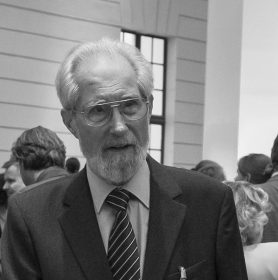27 May 1934 – 6 April 2018

Reinhard Rürup; Jewish Museum Berlin, photo: Svea Pietschmann
The Jewish Museum Berlin mourns the loss of Reinhard Rürup. He died on Friday at age 83. Although as a historian his name is most associated with the Berlin Topography of Terror Foundation, the Jewish Museum Berlin also owes much to his work.
Already in 1989, he was an expert member of the jury for the architecture competition that resulted in the Libeskind building. Ten years later, he was a member of the academic advisory council for the permanent collection opened in 2001. He was also among the few who, from a very early stage, advocated for the founding of an independent, federally sponsored Jewish Museum.
His lecture remains unforgettable for those present at the opening ceremony for the laying of the cornerstone of the Libeskind building, held in the chamber music hall of the Berlin Philharmonie on 9 November 1992. As soon as he stepped up to the lectern, he pulled out the two tickets that had been sent to him for the event. He had realized in surprise that the two organizing senate committees were using different names for the building project.
Reinhard Rürup’s habitually meticulous reading had led him to the heart of this long-smoldering conflict about the status of the planned “museum in a museum.” And he was the first to speak of it publicly. And so he began his ceremonial lecture with critical comments, with doubts about the practicality of this construction, and with the insight that the public already understood the building as “the new Jewish Museum.”
Five years later, his warning about the further escalation of the conflict was confirmed. Before the Committee for Science, Research, and Culture of the Berlin state parliament, he called for an independent museum in the Libeskind building, and federal engagement for this new institution. In October 1997, he presumably did not expect that further developments would prove him right.
But regardless of their outcome, this episode illustrates the prominent features of Reinhard Rürup’s character: rigorous reading and perceptive analysis, precise formulations, well-founded criticism, always presented politely and sometimes with a hint of irony; understanding of the public as the target audience for representations of history, and ultimately the courage to also take unpopular positions and remain loyal to them.
For him, the study of history always took place for and in the arena of civil society. It lent democracy and the constitutional state their necessary historical dimension. Engagement with history was always a political and social task that was supposed to challenge people to take political responsibility in the present. This self-understanding as a public historian goes far beyond what is expressed in the term “mediation,” although it contains dimensions of it.
For Reinhard Rürup, it was beyond dispute that all popular forms must also reflect the most current research. The exhibitions he supervised were based on intensive research, and were themselves contributions to scholarship. He never sacrificed scholarly quality for the sake of popularity. And despite his linguistic clarity and understandable style, he never spared his audience uncomfortable insights.
His involvement with exhibitions and museums began in the early 1980s, when the broad movement for “history from below” focused attention on non-written sources and forms of representation; authentic locations, buildings, objects, images, and stories; and therefore on exhibitions and museums.
He is largely to thank for the fact that Jewish history was taken into account in the large exhibitions on the history of Prussia in 1981 and the history of Berlin in 1987. In 1995, he dedicated an independent exhibition to Berlin’s Jewish history in the newly opened New Synagogue Berlin – Centrum Judaicum Foundation.
His engagement with Jewish history reaches back to the 1960s. He is among those who reestablished this domain of research in the Federal Republic. Using the example of the debates on the emancipation of the Jews in Baden, he formulated an interpretation of the ambivalence of this process and the political idea of liberalism that supports it, an interpretation that remains valid to this day.
Among his core beliefs was that the history of the Jews in Germany cannot be written and shared without consciousness of the catastrophe of its end. However, he also believed that this history didn’t necessarily have to end with this catastrophe, but rather that since 1933 it has been open and malleable. The free, democratic, constitutional, and pluralistic traditions that he also researched formed positive points of reference. Within this constellation, he interpreted the history of the Jews in Germany as one of opportunity and success, without denying its antagonisms and misfortunes. As a unique development in Europe, for him, it paradigmatically represented questions of pluralistic society in the modern era.
Many of those who began engaging with Jewish history in the past decades passed through his “school,” without his ever intending to form a “school” in the academic, paternalistic sense. His ideas, his lines of questioning, and his ethos are carried on by a new generation working at universities, memorial sites, and of course at Jewish museums.
The Jewish Museum Berlin will miss Reinhard Rürup for his clear vision, his critical advice, and not least for the special tone in which he presented them.